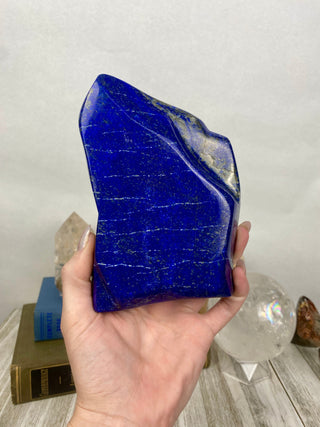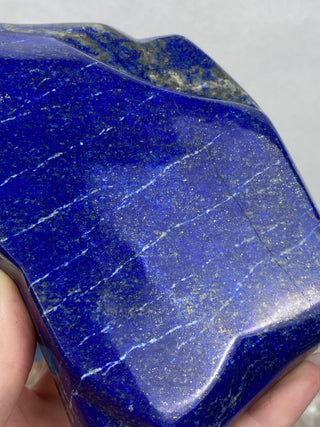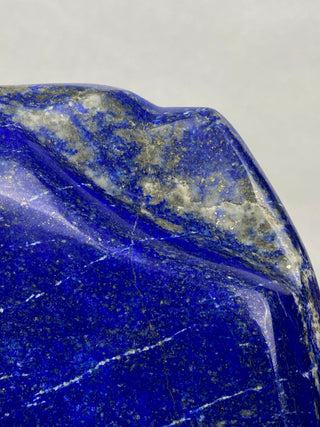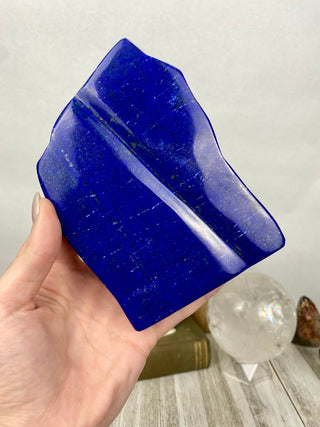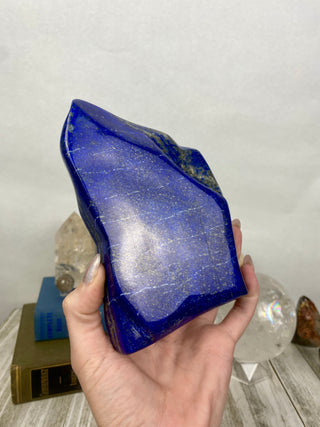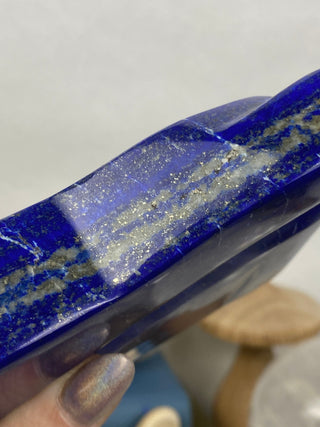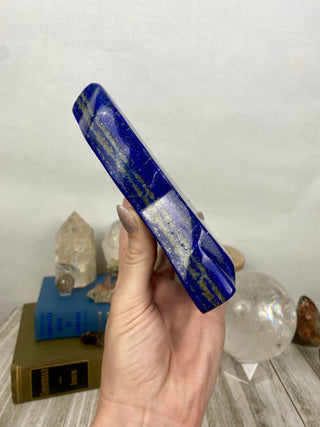Rich blue Afghan Lapis Lazuli slab with sparkly pyrite flakes throughout and polished to a high shine.
Measurements: 910 grams, Height: 15.5cm x Width: 10.5cm (at widest) x Depth: 2.5cm
Lapis Lazuli is a vibrant blue metamorphic rock mainly composed of the mineral lazurite, which typically accounts for 25% to 40% of its overall composition. Alongside lazurite, Lapis Lazuli often contains calcite, visible as white veins or mottling, and pyrite, which introduces metallic golden flecks. Other minerals, including sodalite, hauyne, and diopside, may also contribute to the rock's distinct appearance and properties.
Lapis lazuli forms through contact metamorphism, where limestone or marble undergoes high temperatures and pressures, usually near igneous intrusions. This geological process allows lazurite to replace sections of the host rock, resulting in the characteristic blue color and the formation of various mineral inclusions. Major lapis lazuli deposits are primarily found in Afghanistan, particularly in the Sar-e-Sang mines, which have been mined for millennia. Other significant sources include regions in Chile, Russia, and parts of the United States, such as California and Colorado.
This listing is for one crystal, as pictured. Please see all the photos and videos, and feel free to message me if you have any further questions. I take pictures in lighting that is most representative of the crystal, but monitor settings may slightly affect the colors displayed on your screen.
All crystals have been carefully hand-selected for their quality and aesthetic appeal, ensuring you receive a beautiful piece.
Rich blue Afghan Lapis Lazuli slab with sparkly pyrite flakes throughout and polished to a high shine.
Measurements: 910 grams, Height: 15.5cm x Width: 10.5cm (at widest) x Depth: 2.5cm
Lapis Lazuli is a vibrant blue metamorphic rock mainly composed of the mineral lazurite, which typically accounts for 25% to 40% of its overall composition. Alongside lazurite, Lapis Lazuli often contains calcite, visible as white veins or mottling, and pyrite, which introduces metallic golden flecks. Other minerals, including sodalite, hauyne, and diopside, may also contribute to the rock's distinct appearance and properties.
Lapis lazuli forms through contact metamorphism, where limestone or marble undergoes high temperatures and pressures, usually near igneous intrusions. This geological process allows lazurite to replace sections of the host rock, resulting in the characteristic blue color and the formation of various mineral inclusions. Major lapis lazuli deposits are primarily found in Afghanistan, particularly in the Sar-e-Sang mines, which have been mined for millennia. Other significant sources include regions in Chile, Russia, and parts of the United States, such as California and Colorado.
This listing is for one crystal, as pictured. Please see all the photos and videos, and feel free to message me if you have any further questions. I take pictures in lighting that is most representative of the crystal, but monitor settings may slightly affect the colors displayed on your screen.
All crystals have been carefully hand-selected for their quality and aesthetic appeal, ensuring you receive a beautiful piece.
